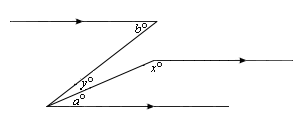Solved Examples and Worksheet for Parallel Lines and Transversals
Step: 1
a + 35° = 70°
[Alternate Interior Angles
Theorem.]
Step: 2
a = 35°
[Simplify.]
Step: 3
a + x = 180°
[Same-Side Interior Angles Theorem.]
Step: 4
35° + x = 180°
[Substitute.]
Step: 5
x = 145°
[Simplify.]
Correct Answer is : 145°
Step: 1
m∠ECD = 180°
[∠ECD is a straight angle.]
Step: 2
m∠ECB + m∠BCD = 180°
[Angle Addition Postulate.]
Step: 3
140° + m∠BCD = 180°
[Substitute.]
Step: 4
m∠BCD = 40°
[Simplify.]
Step: 5
m∠ABC = m∠BCD
[Alternate Interior Angles Theorem.]
Step: 6
m∠ABC = 40°
[Substitute.]
Correct Answer is : 40°

A. 13
B. 52
C. 106
D. 117
E. 128
Step: 1
The two labeled angles are supplementary angles and hence their sum is equal to 180o.
Step: 2
4x + 9x + 11 = 180
Step: 3
13x + 11 = 180
Step: 4
13x = 169 ⇒ x = 13
Correct Answer is : 13
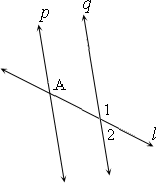
A. m∠1 = 250 and m∠2 = 62
B. m∠1 = 55 and m∠2 = 125
C. m∠1 = 125 and m∠2 = 55
D. m∠1 = 235 and m∠2 = 125
Step: 1
If two parallel lines are cut by a transversal, then the corresponding angles are congruent.
[Corresponding angles postulate.]
Step: 2
∠1 = 125°
[Corresponding angles.]
Step: 3
∠1 + ∠2 = 180°
[Linear Pair.]
Step: 4
125° + ∠2 = 180°
Step: 5
∠2 = 180°- 125°
Step: 6
∠2 = 55°
Step: 7
Hence m∠1 = 125 and m∠2 = 55
Correct Answer is : m∠1 = 125 and m∠2 = 55
Step: 1
From the figure, x° = 2y° ⇒ 12x° = y°
[Alternate angles.]
Step: 2
From the figure, x° + y° = 180°
[Supplementary angles.]
Step: 3
x° + y° = 180° ⇒ x° + 12x° = 180°
[From step 1 and step 2.]
Step: 4
⇒ x° = 120°.
[Solve for x.]
Correct Answer is : 120

A. complementary.
B. congruent.
C. supplementary.
D. none of the above
Step: 1
∠4 + ∠5 = 180o
[Same-Side Interior Angles Theorem.]
Step: 2
∠4 and ∠5 are Supplementary.
[Step 1.]
Correct Answer is : supplementary.
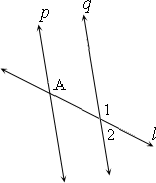
A. m∠1 = 45 and m∠2 = 135
B. m∠1 = 270 and m∠2 = 67
C. m∠1 = 225 and m∠2 = 135
D. m∠1 = 135 and m∠2 = 45
Step: 1
If two parallel lines are cut by a transversal, then the corresponding angles are congruent.
[Corresponding angles postulate.]
Step: 2
∠1 = 135°
[Corresponding angles.]
Step: 3
∠1 + ∠2 = 180°
[Adjacent angles.]
Step: 4
135° + ∠2 = 180°
Step: 5
∠2 = 180°- 135°
Step: 6
∠2 = 45°
Step: 7
Hence m∠1 = 135 and m∠2 = 45
Correct Answer is : m∠1 = 135 and m∠2 = 45
Step: 1
m∠ECD = 180
[∠ECD is a straight angle.]
Step: 2
m∠ECB + m∠BCD = 180
[Angle Addition Postulate.]
Step: 3
130 + m∠BCD = 180
[Substitute.]
Step: 4
m∠BCD = 50
[Simplify.]
Step: 5
m∠ABC = m∠BCD
[Alternate Interior Angles Theorem.]
Step: 6
m∠ABC = 50
[Substitute.]
Correct Answer is : 50
Step: 1
m∠ECD = 180
[∠ECD is a straight angle.]
Step: 2
m∠ECB + m∠BCD = 180
[Angle Addition Postulate.]
Step: 3
160 + m∠BCD = 180
[Substitute.]
Step: 4
m∠BCD = 20
[Simplify.]
Step: 5
m∠ABC = m∠BCD
[Alternate Interior Angles Theorem.]
Step: 6
m∠ABC = 20
[Substitute.]
Correct Answer is : 20
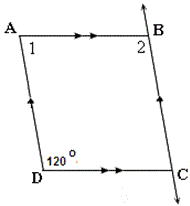
A. m∠1 = 60 and m∠2 = 120
B. m∠1 = 100 and m∠2 = 60
C. m∠1 = 120 and m∠2 = 60
D. m∠1 = 120 and m∠2 = 80
Step: 1
If two parallel lines are cut by a transversal, then the pairs of Same-side interior angles are supplementary.
[¯AB and ¯DC are parallel lines cut by a transversal ¯AD.]
Step: 2
∠1 + 120° = 180°
[Same - side interior angles theorm.]
Step: 3
∠1 = 180° - 120° = 60°
[Simplify.]
Step: 4
m∠1 + m∠2 = 180
[Same - side interior angles theorm.]
Step: 5
60 + m∠2 = 180
[From step 3.]
Step: 6
m∠2 = 180 - 60 = 120
[Simplify.]
Step: 7
So, m∠1 = 60 and m∠2 = 120
Correct Answer is : m∠1 = 60 and m∠2 = 120
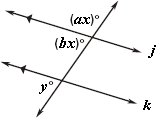
A. x = 15 and y = 17
B. x = 15 and y = 150
C. x = 15 and y = 30
D. x = 7 and y = 14
Step: 1
10x° + 2x° = 180°
[Adjacent angles.]
Step: 2
12x° = 180°
Step: 3
x° = 180°12 = 15°
Step: 4
If two parallel lines are cut by a transversal, then the corresponding angles are congruent.
[Corresponding angles postulate .]
Step: 5
y = (2x)
[From step 4.]
Step: 6
y = 215 = 30
Step: 7
So, x = 15 and y = 30
Correct Answer is : x = 15 and y = 30
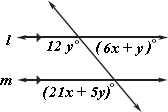
A. x = 6 and y = 18
B. x = 12 and y = 4
C. x = 4 and y = 8
D. x = 4 and y = 12
Step: 1
If two parallel lines are cut by a transversal, then the corresponding angles are congruent.
[Corresponding angles postulate.]
Step: 2
12y° = (21x + 5y)°
[Corresponding angles.]
Step: 3
7y = 21x ⇒ y = 3x
[Simplify.]
Step: 4
12y° + (6x + y)° = 180°
[Adjacent angles.]
Step: 5
13y + (6x) = 180°
[Simplify.]
Step: 6
13(3x) + 6x = 180 ⇒ 45x = 180
[Substitute y = 3x and simplify.]
Step: 7
x = 18045 ⇒ x = 4
[Simplify.]
Step: 8
y = 34 = 12
[From step 3.]
Step: 9
So, the values of x and y are 4 and 12.
Correct Answer is : x = 4 and y = 12
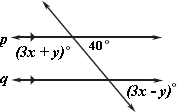
A. x = 40
B. x = 60
C. x = 50
D. x = 30
Step: 1
From the data, one of the large angles is (3x + y)°.
Step: 2
From the data, two of the small angles are 40° and (3x - y)°.
Step: 3
If a transversal intersects two or more parallel lines, all small angles are equal.
Therefore, 3x - y = 40 ---- 1
Therefore, 3x - y = 40 ---- 1
Step: 4
If a transversal intersects two or more parallel lines, then sum of small angle and large angle equals straight angle.
Therefore, 3x + y + 40 = 180
3x + y = 140 ---- 2
Therefore, 3x + y + 40 = 180
3x + y = 140 ---- 2
Step: 5
Now, add equation 1 and equation 2 and solve for x.
6x = 180
x = 30
6x = 180
x = 30
Correct Answer is : x = 30
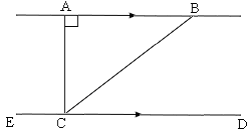
A. 30
B. 150
C. 330
D. 105
Step: 1
m∠ECD = 180
[∠ECD is a straight angle.]
Step: 2
m∠ECB + m∠BCD = 180
[Angle Addition Postulate.]
Step: 3
150 + m∠BCD = 180
[Substitute.]
Step: 4
m∠BCD = 30
[Simplify.]
Step: 5
m∠ABC = m∠BCD
[Alternate Interior Angles Theorem.]
Step: 6
m∠ABC = 30
[Substitute.]
Correct Answer is : 30
- Points, Rays, Angles, Lines and Line Segments-Geometry-Solved Examples
- Angle Sum Theorem and Medians in a Triangle-Geometry-Solved Examples
- Properties of Isosceles Triangles-Geometry-Solved Examples
- Proving Quadrilateral is a Parallelogram-Geometry-Solved Examples
- ASA and AAS Postulates -Triangle Congruence-Geometry-Solved Examples
- SSS and SAS Postulates-Triangle Congruence-Geometry-Solved Examples
- Transformations-Reflections-Geometry-Solved Examples
- Transformations-Rotations-Geometry-Solved Examples
- Transformations-Translations-Geometry-Solved Examples

